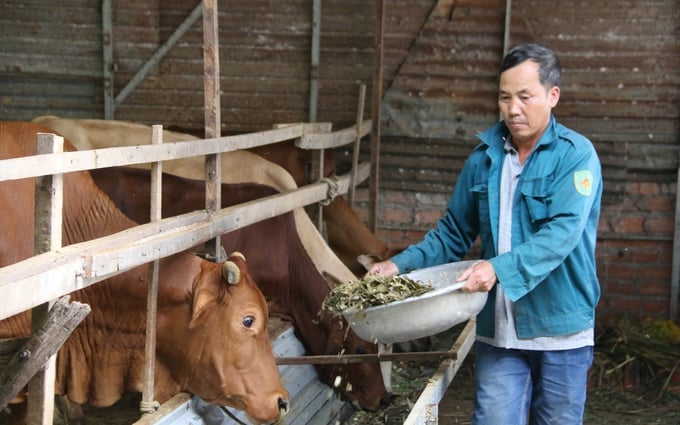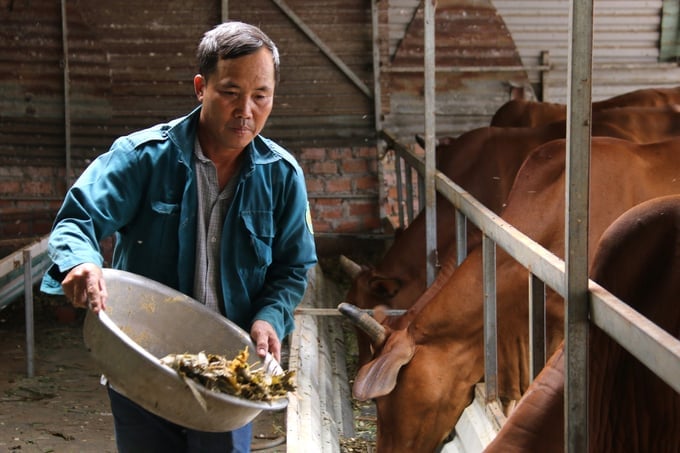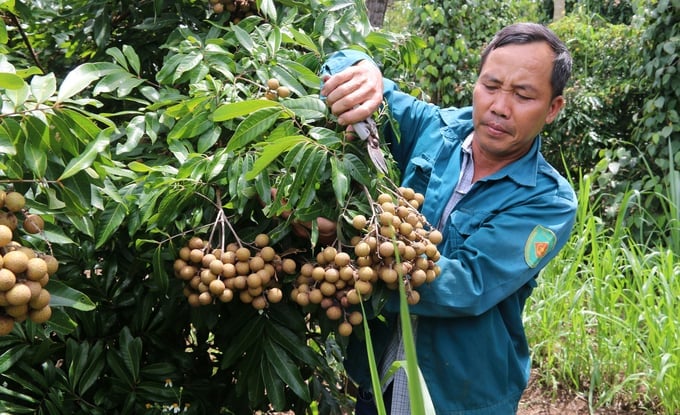November 25, 2025 | 21:54 GMT +7
November 25, 2025 | 21:54 GMT +7
Hotline: 0913.378.918
November 25, 2025 | 21:54 GMT +7
Hotline: 0913.378.918

Mr. Diem utilizes his neighbor's cornstalks to ferment feed for the cattle. Photo: Quang Yen.
Mr. Phung Trong Diem, a fifty-year-old farmer from Hamlet 12, Cu K’nia commune, Cu Jut district, Dak Nong province, has been processing corn stalks to create reserved feed for his herd of 25 cattle.
According to Mr. Diem, he capitalizes from the local residents' corn harvest season by collecting whole corn stalks for cutting and processing. Subsequently, the corn stalks undergo fermentation by being cultured with cornmeal, microbial cultures, and salt to produce nutritious feed for the cattle.
"Several years ago, I took out a policy bank loan to purchase cattle for production. Initially, the traditional farming methods did not yield high economic returns. I learned about processing cattle feed from cornstalks while watching television, so I experimented with the technique. After over five years of application, my herd of cattle has developed remarkably well, with an annual sale of approximately 18 to 20 beef calves," shared Mr. Diem.
According to Mr. Diem, corn stalks contain high nutritional content, making them suitable animal feed for buffaloes, cattle, deer, among others. Excess corn stalks are often discarded or used as inefficient fuel after the harvest season, thereby wasting their potential.
After researching the fermentation and culturing process for cornstalks, Mr. Diem has effectively utilized the local agricultural by-products as cattle feed. Notably, the use of this feed has facilitated the excellent development of his cattle, reduced rearing costs, and ensured an organic fertilizer source for family production.
"In addition to fresh grass, I feed the cattle fermented cornstalks every day. The cattle consuming this fermented feed show no signs of stomach discomfort, diarrhea, or occurrences of diseases. The process of processing cornstalks is straightforward, but the most crucial aspect is ensuring hygiene during fermentation, preventing air and water from entering the fermentation bag," added Mr. Diem.
Particularly, the land in Mr. Diem's area mainly consists of stony, lateritic soil. Similar to many other farmers in the region, Mr. Diem had previously invested a significant amount in cultivating pepper. However, due to disease contamination, causing mass deaths of the pepper plants, Mr. Diem shifted to cultivating fruit trees.

Mr. Diem's cattle exhibited excellent growth with the use of cornstalks as feed. Photo: Quang Yen.
"After extensively researching and seeking opinions, my family decided to cultivate longans due to the local water scarcity. In cases of heavy rain, water typically drains quickly enough without affecting the trees' growth. So far, we have planted 1 hectare of longan trees. The longan trees have reached their fourth year and begun producing fruits. We recently harvested over 7 tons of fruit, and subsequently sold on the field for 17,000 Vietnamese dong per kilogram. Compared to pepper cultivation, longan trees require much less labor and care efforts," Mr. Diem shared.
Mr. Diem emphasized that fertilizer for the longan farm is obtained entirely from organic cattle farming. With an average of 20 to 25 head of cattle maintained annually, the surplus manure serves as fertilizer for the 1-hectare longan farm.
To date, Mr. Diem's family earns nearly 400 million Vietnamese dong annually from both cattle farming and longan cultivation. They have managed to repay the bank loan and have expanded their production scale. In addition to the longan farm, Mr. Diem practices intercropping with male papaya plants to harvest flowers, which are sold to traders for medicinal purposes.

Mr. Diem's family utilizes cattle manure as a fertilizer for longan cultivation to increase income. Photo: Quang Yen.
"After a short implementation period, male papaya plants have shown great economic efficiency. They are easy to grow, require minimal care and low initial investment, which is suitable for the natural conditions of Cu K’nia commune. The cultivation of these varieties utilizes the manure from cattle production, thereby reducing associated costs and improving the family's income," Mr. Diem explained.
Ms. Nguyen Thi Ut, Vice Chairwoman of the Cu K’nia Commune People's Committee, commented on Mr. Diem's model: "Mr. Diem is among the local farmers at the forefront of economic development. Accordingly, he has effectively applied various agricultural programs and economic farm models to high efficiency. Throughout the production process, Mr. Diem also actively supports and aids other households in the village, contributing to improving the landscape and livelihoods of the people in this impoverished area of Hamlet 12."
Translated by Nguyen Hai Long
/2025/11/24/3536-2-112800_176.jpg)
(VAN) Dong Nai now has tens of thousands of hectares of forests certified for sustainable management, and this area will continue to be expanded in the coming period.

(VAN) Vinh Ha hamlet (Dai Xuyen commune, Hanoi) is shifting away from small-scale farming as households adopt bioscurity into their breeder chicken models.

(VAN) Heavy rains make aquatic species more vulnerable to disease. Proactive water management and high-tech systems help farmers prevent outbreaks and protect yields.

(VAN) Greenhouses are shifting production mindsets in Binh Lu commune, enabling farmers to ‘weather the sun and rain’ and secure stable vegetable harvests throughout the year.

(VAN) Green transition is crucial for the Mekong Delta amid climate change and stricter standards, offering a path toward sustainability.

(VAN) Dong Thap promotes agricultural restructuring, forms large specialized farming zones, raises the value of agricultural products and develops toward ecological and high-tech directions.
/2025/11/22/4018-4-213342_747.jpg)
(VAN) The Mekong Delta Agricultural Experts Club has attracted 143 experts and researchers to participate in providing consultancy and contributing initiatives to the development of one million hectares of high-quality rice.